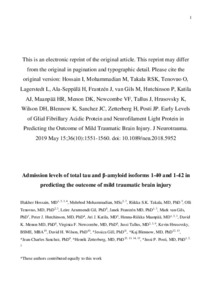Early Levels of Glial Fibrillary Acidic Protein and Neurofilament Light Protein in Predicting the Outcome of Mild Traumatic Brain Injury
Hossain I; Mohammadian M; Takala RSK; Tenovuo O; Lagerstedt L; Ala-Seppälä H; Frantzén J; van Gils M; Hutchinson P; Katila AJ; Maanpää HR; Menon DK; Newcombe VF; Tallus J; Hrusovsky K; Wilson DH; Blennow K; Sanchez JC; Zetterberg H; Posti JP
https://urn.fi/URN:NBN:fi-fe2021042825844
Tiivistelmä
The purpose of this study was to correlate the early levels of glial fibrillary acidic protein (GFAP) and neurofilament light protein (NF-L) with outcome in patients with mild traumatic brain injury (mTBI). A total of 107 patients with mTBI (Glasgow Coma Scale ≥13) who had blood samples for GFAP and NF-L available within 24 h of arrival were included. Patients with mTBI were divided into computed tomography (CT)–positive and CT-negative groups. Glasgow Outcome Scale-Extended (GOSE) was used to assess the outcome. Outcomes were defined as complete (GOSE 8) versus incomplete (GOSE <8), and favorable (GOSE 5–8) versus unfavorable (GOSE 1–4). GFAP and NF-L concentrations in blood were measured using ultrasensitive single molecule array technology. Patients with incomplete recovery had significantly higher levels of NF-L compared with those with complete recovery (p = 0.005). The levels of GFAP and NF-L were significantly higher in patients with unfavorable outcome than in patients with favorable outcome (p = 0.002 for GFAP and p < 0.001 for NF-L). For predicting favorable outcome, the area under the receiver operating characteristic curve for GFAP and NF-L was 0.755 and 0.826, respectively. In a multi-variate logistic regression model, the level of NF-L was still a significant predictor for complete recovery (odds ratio [OR] = 1.008; 95% confidence interval [CI], 1.000–1.016). Moreover, the level of NF-L was a significant predictor for complete recovery in CT-positive patients (OR = 1.009; 95% CI, 1.001–1.016). The early levels of GFAP and NF-L are significantly correlated with the outcome in patients with mTBI. The level of NF-L within 24 h from arrival has a significant predictive value in mTBI also in a multi-variate model.
Kokoelmat
- Rinnakkaistallenteet [27094]
